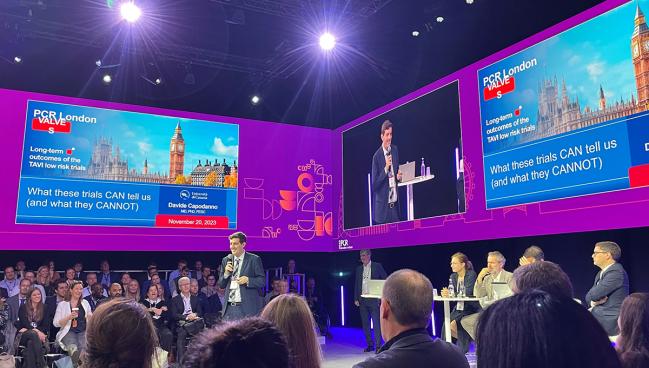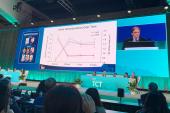Looking for a Winner Between Long-term TAVI Trials? Don’t, Experts Urge
Directly comparing PARTNER 3 and Evolut Low Risk results is like “discussing reincarnation,” one prominent statistician warns.

LONDON, England—Ever since the 5-year PARTNER 3 and 4-year EVOLUT Low Risk results were released at TCT 2023, clinicians and researchers—not to mention industry players and ad execs—have been comparing numbers and graphs side by side to look for similarities and differences, winners and losers. Last week, a fast-paced session at PCR London Valves put these data and discussions on center stage once again to address, where possible, many of the questions that have arisen so far. Chief among them: is one TAVI valve better than the other for aortic stenosis patients at low surgical risk?
As reported by TCTMD, the PARTNER 3 data that Martin Leon, MD (NewYork-Presbyterian/Columbia University Irving Medical Center, New York, NY), presented at TCT last month showed there was no significant difference in the risk of death, disabling stroke, or rehospitalizations at 5 years between the balloon-expandable TAVI valve (Sapien 3; Edwards Lifesciences) and a range of surgical bioprostheses (22.8% vs 27.2%; P = 0.07). Meanwhile, 4-year data from the Evolut Low Risk trial, presented at TCT by Michael Reardon, MD (Methodist DeBakey Heart & Vascular Center, Houston, TX), showed that rates of death or disabling stroke—the primary endpoint—was 3.4% lower in TAVI patients than in SAVR patients, a difference that narrowly met a P value of 0.05.
The long-term results from PARTNER 3 were published in the New England Journal of Medicine and those from Evolut Low Risk in the Journal of the American College of Cardiology.
Several things set chins wagging. The first was the observation that Kaplan-Meier estimates for the primary endpoint in the Evolut trial separated early, with the curves continuing to diverge ever since. By contrast, in the PARTNER 3 trial, Kaplan-Meier estimates for the primary endpoint, which initially showed a marked benefit for TAVI, have been converging over time.
Other questions were prompted by survival as a stand-alone endpoint. In PARTNER 3, the all-cause death rate was numerically higher with TAVI vs SAVR (10.0% vs 8.2%) at 5 years, with survival curves crossing roughly at 36 months. In Evolut Low Risk, all-cause deaths numerically favored TAVI over SAVR (9.0% vs 12.1%) at 4 years.
Despite all entreaties made at TCT to avoid indirectly comparing devices in different trials, these numbers have only fanned the debate on blogs and social media. Is Evolut the better, safer valve? Were the PARTNER 3 patients sicker? Does the higher percentage of surgical deaths in the Evolut trial indicate that this trial’s surgeons were less skilled? And what about the valves those surgeons used?
Forum Gladiators
At London Valves, both lead investigators were allotted just 5 minutes to sum up their studies in a “forum”-style setting—a packed audience on three sides, no podium, trial details projected on every wall. Leon provided a rapid-fire recap of the more detailed presentation he’d given at TCT
Reardon took a slightly different approach. After opening with a profuse thank you to Leon “for running these tremendous trials [and] for what you’ve done for the field of TAVR,” he shared a range of previously presented data that indirectly addressed the questions raised since TCT.
TAVI design is key for long-term durability, he stressed, citing an analysis he’d presented in 2022 as well as another from earlier this year, showing the self-expanding valve to be superior to SAVR across multiple measures of structural valve deterioration. Patient mix matters, too, he added, noting that less than 15% of patients screened for Evolut Low Risk were excluded from randomization, but that the overall makeup of the population was “at the higher end of low risk.”
Lastly, addressing insinuations that surgery was “better” in PARTNER 3 than in the Evolut Low Risk trial (with surgical mortality rates of 8.2% versus 12.1%, respectively), Reardon noted that surgical mortality in the high- and intermediate-risk trials had been higher for the Edwards balloon-expandable valve than for the Medtronic CoreValve and Evolut devices.
“Were the PARTNER surgeons bad surgeons in some way? No. They're excellent surgeons. I know them personally. These were different populations,” Reardon insisted. “I'd say the surgical operator, and surgical valve selection, really were best in class. There's no question about that in my mind.”
But both Leon and Reardon were adamant the trial data they presented can only be used to compare the TAVI valves studied against surgery—neither the transcatheter valves, nor the surgical outcomes can be directly compared.
To TCTMD, Leon lamented the session format, which had no time for rebuttal. He disagreed that PARTNER 3 enrolled a “lower-low-risk” population than Evolut and suggested that both trials have to account for certain curiosities. “PARTNER needs to explain why there was some catch-up in mortality during the study follow-up, and Evolut Low Risk has to explain why the surgical arm had a more than twofold higher all-cause mortality rate at 4 years, which exaggerated the relative outcome differences,” he said.
As for whether the hemodynamics heralded by Reardon prove prophetic for TAVI valve success, Leon said only time will tell. Early echocardiographic data looked good for the TRIFECTA surgical valve, he noted—the surgical bioprosthesis was pulled from the market earlier this year on the grounds of accelerated structural deterioration.
Reardon, to TCTMD, made a similar point. “Listen, this was good for both valves, because they’re both noninferior to the big endpoints of mortality and stroke. Going forward, it may make a difference” which TAVI valve is used, but more follow-up is needed, he continued. “If I had to choose which side I'd want to be on, I'd rather be on my side, but I'm unwilling to take a definitive [stand] because I’ve been wrong about surgical valves before.”
Synthesis and Esotericism
Stepping into the ring after the trialists was Davide Capodanno, MD, PhD (University of Catania, Italy).
“I was asked to give a critical reading of the two trials, and I share the conclusion that the two trials should not be compared,” he said. “But in order to convince you that they should not be compared, I'll compare them.”
Capodanno’s talk delved into side-by-side assessments of study participants, interventions, control groups, and outcomes, ultimately concluding that at least based on the data in the public domain, there is no basis to think one study or device was superior to the other.
“The use of the surgical arm of these trials as a reference to compare the efficacy and safety of Sapien 3 and EVOLUT R or Pro, for me, is misleading,” he said. “Differences between the trials in terms of endpoints, follow up, unmeasured confounders, and undisclosed information warrant careful consideration in comparative analysis.”
Coming to any conclusions about the comparative performance of either the surgeons in these two trials or the TAVI devices in these two trials is like discussing reincarnation. Peter Jüni
If the audience remained unconvinced after Capodanno’s careful comparison, panelist and statistician Peter Jüni, MD (University of Oxford, England), was even more colorful in his remarks, saying he “couldn’t care less” about the 0.05 P value as compared to 0.07.
“I need to emphasize here that coming to any conclusions about the comparative performance of either the surgeons in these two trials or the TAVI devices in these two trials is like discussing reincarnation,” he commented. “It's purely esoteric.”
Remember the “gospel” of statistical methodology, Jüni continued: “Never never ever, never ever ever compare absolute rates in trials. It's not possible because you do not understand what the differences are. And some of the discussions that were out there,” he said. “This for me really was just like running against the wall of concrete—what happened in social media, It's just nonsense. And you need to be aware of it.”
Referring to the discussion around the different Kaplan-Meier curves, Jüni observed that humans are “really good at pattern recognition” but also will see patterns where none exist. Here, he said, “we do not know whether the patterns are real or not, because we have not enough events.”
Going Head-to-Head
What’s needed is a head-to-head trial, something industry has no interest in funding, Reardon later observed to TCTMD. But such a study, Capodanno noted, is already underway. Led by Eric Van Belle, MD, PhD (University Hospital, Lille, France) the BEST trial kicked off in January 2023 and aims to randomize 1,800 participants with severe aortic valve stenosis between the latest-generation balloon-expandable and self-expanding devices. The trial is powered for superiority, with a primary endpoint of death from any cause at 90 days and 1 year. “We will see whether it's the ‘best’ or not,” Capodanno said, adding that completion is expected in 2025. “This is what we need in order to decide whether there is a population which benefits more from one valve versus the other.”
Longer follow-up will also be key. Before he left the “forum,” Reardon threw down the gauntlet, saying he’s persuaded Medtronic to release yearly reports out to 10 years. Leon, in turn, said PARTNER 3 patients will also be followed out to 10 years and that he intends to release “interim” data at 8 years.
However, in a nod to the fact that both trials have done well at tracking TAVI patients but have seen substantial loss to follow-up among surgically treated patients, Leon offered a caveat: “As we get out further and further, there's more and more missing data, there's more and more disproportionate withdrawal, so we need to keep that in mind.”
Both Leon and Reardon also made the point that their respective trials enrolled older adults, most of whom were over age 70—and that’s the only population their reassuring low-risk findings apply to. That’s worth remembering, said panelist and cardiothoracic surgeon Michael A. Borger, MD, PhD (Heart Center of Leipzig, Germany), noting that in the US, 47.5% of patients getting TAVR are under age 65.
Shelley Wood is the Editor-in-Chief of TCTMD and the Editorial Director at CRF. She did her undergraduate degree at McGill…
Read Full BioSources
Multiple sessions. Presented at: PCR London Valves. November 20, 2023. London, England.
Disclosures
- Leon reports grant support from Abbott, Boston Scientific, Edwards Lifesciences, and Medtronic. He reports consulting for Anteris and Foldax.
- Reardon reports grant support from Medtronic, Abbott, Boston Scientific, and WL Gore.





Comments